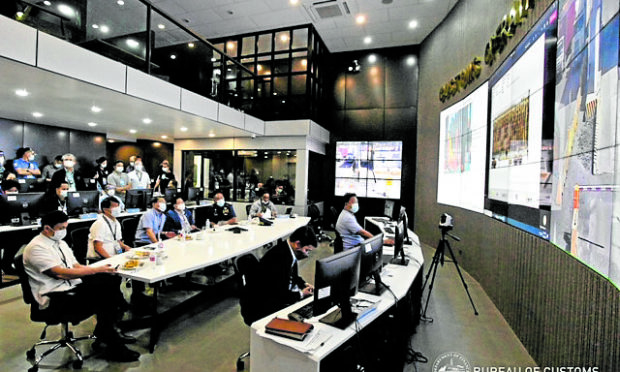
BOC launches the Customs Operation Center to integrate intelligence, enforcement, risk management and scanning systems.
When one thinks about the Bureau of the Customs (BOC), the next thought is almost always rampant graft and corruption. And for various reasons, many of them entirely justified.
But the current leadership led by Commissioner Rey Leonardo Guerrero is intent on removing that stigma stubbornly attached to the government agency that will celebrate its 119th anniversary tomorrow.
After all, the BOC is mandated to perform key functions, including assessing and collecting customs revenues, curbing illicit trade and facilitating the exchange of goods within and outside the country’s borders through an efficient and effective customs management system.
And they believe they are well on their way to making BOC achieve its vision to become “a modern and credible customs administration that will be among the world’s best.”
The BOC, for instance, has embarked on a massive transformation program underpinned by modernization, good governance and values transformation, according to BOC Assistant Commissioner Vincent Philip Maronilla.
“The many steps we undertook in these areas in the last 12 months, especially, were all aimed at, ultimately, helping the market, including new entrepreneurs as well as big players, improve their business,” Maronilla told the Inquirer.
These include the launch of Customer Care Centers (CCC) in all 17 collection districts serving as front-line offices of the BOC. The CCC is positioned as a one-stop-shop customs hub that serves as a document receiving and releasing area, payment area, pass control issuance center and information kiosk.
“The CCCs were established to provide optimum convenience for all customers, and to fully implement the no contact policy to eradicate corruption opportunities,” Maronilla said.
The pioneer CCC at the Port of Manila was certified ISO 9001:2015 in November 2020, indicating its ability to consistently provide services that meet customer and regulatory requirements.
The BOC aims to secure a similar certification for all of its CCCs and offices to bolster the public’s trust and confidence in the agency.
The BOC has also invested in systems that allow online processing of stakeholders’ accreditation, customs documents, payment of miscellaneous fees through PayMaya, and tracking of parcels and shipments. In 2020, the BOC processed accreditations of more than 17,000 stakeholders through the BOC’s online portal.
Then in terms of operational improvement, especially amid the COVID-19 pandemic, Maronilla said the BOC reduced red tape to hasten the filing of goods declaration, assessment and payment of duties and taxes, and releasing of goods.
“The Bureau conducted a Time Release Study in its ports to measure the actual average release time of goods and identify bottlenecks affecting customs clearance. The study in Manila International Container Port shows that the actual customs clearance time for importation was significantly reduced from two days and 10 hours in 2019 to just one day and 22 hours in 2020,” he said.
“In this time of crisis, there is no time and no room for inefficiency as all types of goods call for timeliness and consistency in processing and releasing,” Maronilla stressed.
And to prevent paralyzing bottlenecks at the ports, the BOC has brought its yard utilization rate to below 70 percent, in keeping with global standards and also as a response to the loud call from importers to accelerate the release of goods amid the COVID-19 pandemic.
“The monitoring and supervision of the same significantly prevented the occurrence of port congestion, and allowed the expeditious release of all essential and nonessential goods,” he said.
Also, as part of its goal to align systems and procedures to global benchmarks, the BOC had the key ports at Batangas, Manila and Dumaguete ISO-certified and has vowed to undertake all of the recommendations from the World Customs Organization to ensure its trade facilitation measures are at par with other countries.
In 2020, the World Bank set aside $88.28 million for the Customs Modernization Program, which is intended to fully automate customs processes, lower trade costs, develop new processing systems, and integrate key processes into a single and seamless online system that is comparable to global standards, Maronilla said.
This year, the BOC will highlight the advance ruling program for stakeholders to ensure consistent assessment of a good’s value, add certainty and predictability to international trade and fully implement the Authorized Economic Operator program to secure seamless trading environment across borders, all for better and improved customs transactions, while supporting the rebuilding of the economy. But more than just systems and procedures, the current BOC leadership paid as much attention to values transformation of the entire BOC structure and leadership by example.
“In the past months, we have been institutionalizing good governance principles, coupled with leadership by example, to show we are sincere and serious in implementing change in the Bureau,” he said. “Our goals, commitments and targets are now, therefore, being aligned with our thrust to hold people accountable.”
“Institutionalization is the name of the game here. Our employees are seeing the changes and are happy and proud of the new efficiencies and better services we are able to provide the public. The new systems and procedures that are now in place will continue even when leaders change because they are now part of our good governance practices,” Maronilla added. INQ


